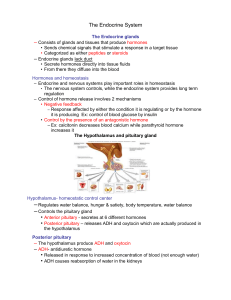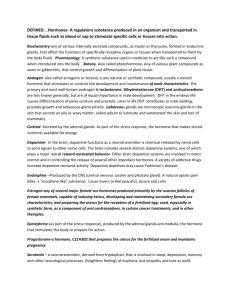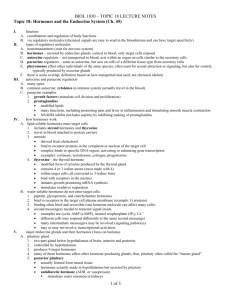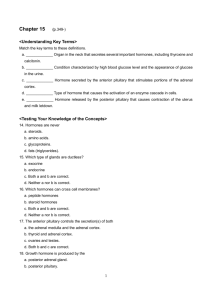Endocrine Glands
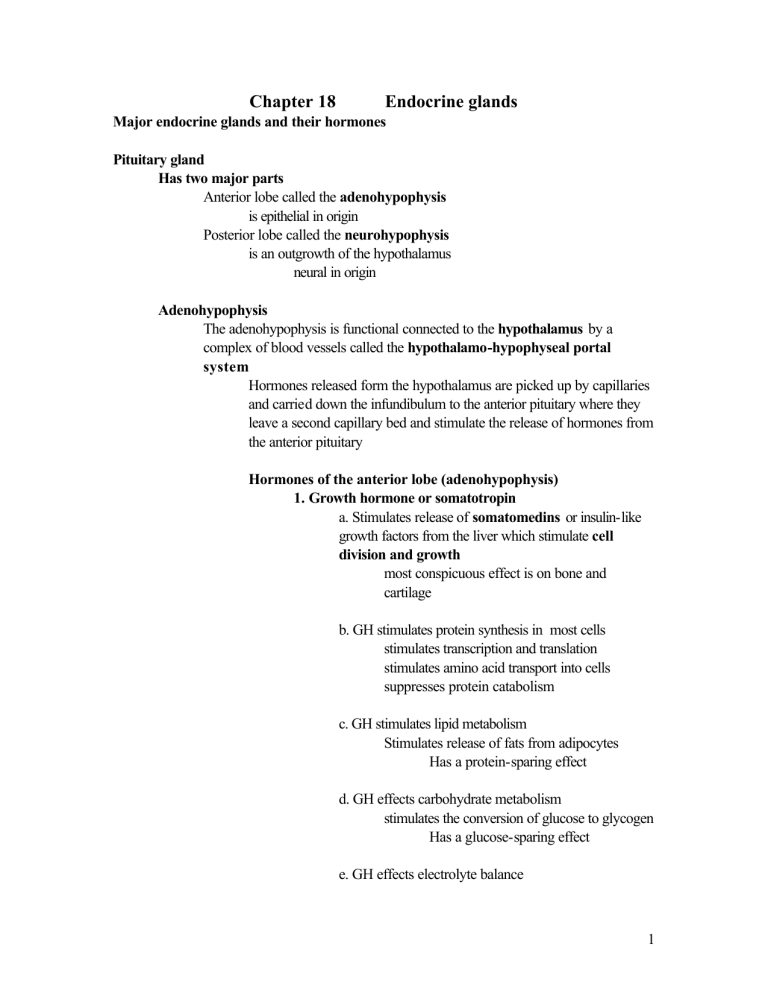
Chapter 18 Endocrine glands
Major endocrine glands and their hormones
Pituitary gland
Has two major parts
Anterior lobe called the adenohypophysis is epithelial in origin
Posterior lobe called the neurohypophysis is an outgrowth of the hypothalamus neural in origin
Adenohypophysis
The adenohypophysis is functional connected to the hypothalamus by a complex of blood vessels called the hypothalamo-hypophyseal portal system
Hormones released form the hypothalamus are picked up by capillaries and carried down the infundibulum to the anterior pituitary where they leave a second capillary bed and stimulate the release of hormones from the anterior pituitary
Hormones of the anterior lobe (adenohypophysis)
1.
Growth hormone or somatotropin a. Stimulates release of somatomedins or insulin-like growth factors from the liver which stimulate cell division and growth most conspicuous effect is on bone and cartilage b. GH stimulates protein synthesis in most cells stimulates transcription and translation stimulates amino acid transport into cells suppresses protein catabolism c. GH stimulates lipid metabolism
Stimulates release of fats from adipocytes
Has a protein-sparing effect d. GH effects carbohydrate metabolism stimulates the conversion of glucose to glycogen
Has a glucose-sparing effect e. GH effects electrolyte balance
1
GH promotes Na, K, and Cl retention by the kidneys and enhances Ca absorption by the small intestine
Necessary for growth
Growth Hormone release
GH release is stimulated by growth hormone releasing hormone (GHRH) from the hypothalamus
Which is released in response to a.
strenuous exercise b.
low blood sugar levels (gestational diabetes) c.
high amino acid levels
2. Prolactin
Initiates and maintains milk production by the mammary glands
Released in response to prolactin releasing hormone from the hypothalamus is released in response high estrogen and progesterone levels during pregnancy and to suckling by the baby
3. Thyroid-stimulation hormone (TSH)
Stimulates the thyroid gland to produce thyroid hormone (see thyroid gland)
Released in response to thyrotropin releasing hormone (TRH) from the hypothalamus
TRH is released when blood levels of thyroid hormone drops
Release is inhibited by high thyroid levels
Negative feedback
4. Adrenocorticotropic hormone (ACTH)
Stimulates the release of several different hormones from the adrenal cortex (see adrenal gland)
Released in response to corticotropin releasing hormone (CRH) from the hypothalamus
2
CRH release is controlled by a negative feedback mechanism when adrenal cortex hormone levels fall
Also released during sympathetic stimulation and stress in general
5. Follicle-stimulating hormone and
6. Luteinizing hormone
In females they stimulate ovarian follicle development and estrogen production
In males they stimulate sperm production and testosterone production
Released in response to gonadotropin releasing hormone (GnRH) from the hypothalamus
GnRH release is controlled by a negative feedback loop
High testosterone or estrogen = low
GnRH)
(More latter during reproduction)
Hormones of the posterior lobe (neurohypophysis)
1.
antidiuretic hormone made by neurons that have their cell bodies in the hypothalamus but extend axons into the neurohypophysis
(stored in pituitary) stimulate the kidney to retain water from the urine this helps control blood volume and thus blood pressure released when osmoreceptors in the hypothalamus sense a drop in the water content of blood release is inhibited by high blood pressure
2.
oxytocin also made by neurons in the hypo released during childbirth and strengthens smooth muscle contraction
3
release during suckling and stimulates milk ejection both are positive feedbacks also released during sexual arousal and orgasm propulsion of semen uterine contractions to move semen up repro tract emotional bonding
Pineal gland
Located beneath the posterior end of the corpus collosum
Secretions peak between 1 to 5 years old and are 75% lower in adults
Releases Serotonin during the day and melatonin at night
May control onset of puberty
Regulate day night cycles
Thyroid gland
Located just below the larynx
Is largest endocrine gland
Releases T4 (Thyroxine ) and T3 (triiodothyronine)
T4 is Two tyrosine residues with 4 iodines attached
T3 is Two tyrosine residues with 3 iodines attached
Are released in response to TSH from the pituitary gland
T3/T4 effects every cell in the body
Increases metabolic rate
Promotes protein synthesis
Stimulates growth during childhood
Enhances neuron function
Enhances neuron growth during childhood
Cretinism occurs if on thyroid homones
Calcitonin
Released from c-cells (clear cells) or parafollicular cells of the thyroid gland
Released in response to high blood calcium levels
More important in children
Effects are to lower blood calcium
4
Stimulates osteoblasts to make bone
Inhibits osteoclasts
Blocks absorption of calcium from diet and reabsorption by kidneys
Parathyroid gland
Located on the posterior surface of the thyroid gland
Secrete parathyroid hormone (PTH)
Is released in response to low blood calcium levels
Effects
Promotes reabsorption of calcium from diet
Simulates the kidneys to convert vitamin D to the hormone calcitriol
Stimulates absorption of calcium from small intestine
Promotes removal of calcium from bone (osteoclasts activity)
Inhibits osteoblast activity
Effects of low blood calcium
Increases sodium permeability and cells become hyper excitable
Leads to convulsions or muscular spasms
Thymus gland
Located over the heart
Is large in infants and children very small in adults
Is the site of T-lymphocyte maturation
Releases a hormone thymosin and thymopoietin
Effects of thymosin and thymopoietin
Stimulates the development and maturation of T-lymphocytes
Adrenal glands
Located on top of each kidney
Functions like two glands in one
Adrenal cortex
Adrenal medullae
Adrenal cortex
5
Secretes three types of hormone (all are steroids)
There is three layers to the adrenal cortex
1. outer layer the releases zona glomerulosa
Mineralocorticoids
Main one is aldosterone
Effects
Stimulates reabsorb sodium and secretion of potassium
Targets
Kidneys, sweat glands, salivary glands and the digestive system
Increases water reabsorption by kidney thus has effect on blood volume and pressure
Also stimulates the consumption of salty foods
Released in response to
Low blood sodium
High blood potassium
Low blood pressure and volume
Presence of angiotensin II
Also releases by presence of ACTH from pituitary
Minor effect
2. middle layer the zona fasciculata releases Glucocorticoids
Main one is cortisol
Effects
Help regulate glucose concentration in the blood by promoting the conversion of noncarbohydrates to glucose
Help body respond to stress by making glucose available to cells
High concentrations depresses immune reactions to reduce inflammation
6
Releases by presence of ACTH from pituitary
3. inner layer the zona reticularis releases Adrenal sex hormones
Both androgens and estrogens are released in men and women
Effects are insignificant in males because most androgens come from testes
In females this accounts for 50% of the androgens
May sustain libido in females
Stimulate development of pubic and axillary hair and stimulate skeletal growth
Releases by presence of ACTH from pituitary but only slightly
Adrenal medulla
Chromaffin cells secretes epinephrine (75%) and norepinephrine
Is released when sympathetic nervous system is activated
(stress)
Effects
Mimic the effects of the sympathetic nervous system
Effects last much longer
Decrease blood flow to viscera and skin
Increase blood flow to skeletal muscle, lungs, cardiac muscle, nervous system
Stimulates the conversion of glycogen to glucose and the breakdown of glucose
Stimulates the adipocytes to convert stored fats to fatty acids
Stimulate cellular metabolism
Increases heart rate and force of contraction
Pancreas
Located posterior to the stomach
Has both endocrine and exocrine function
7
Endocrine function comes from the islets of Langerhans
Islets secret two major hormones
Glucagon
Released from the alpha cells of the islets
Released when blood glucose levels drop
Effects
Increase the concentration of glucose in the blood stream
Stimulates cells to convert glycogen to glucose and convert certain amino acids to glucose
In the liver the glucose can be released into the circulation
Ability to raise glucose levels are similar to epinephrine and norepinephrine
Insulin
Released from the beta cells of the islets
Released when blood glucose levels are high and weakly by high blood amino acid levels
Effects
Decreases blood glucose levels by stimulating the uptake of glucose by the liver, skeletal muscle, and adipocytes
Stimulates cells to convert glucose to glycogen
Stimulates the fat cells to produce fats from glucose
Stimulates protein syntheses, cell growth, and differentiation
Ovaries
Located in the pelvic cavity
Function starts at puberty when FSH and LH release from the anterior pituitary increases
8
Ovaries release two major types of hormones
Estrogens
Is the primary female sex hormone
Released from the developing ovarian follicles (has the egg)
Effects
Stimulate the development and maturation of the female sex organs
Stimulates the formation of secondary sexual characteristics
Female fat distribution
Breasts
Broad hips
Prepare the uterus to receive the fertilized egg
Maintain pregnancy
Prepare breasts to produce milk
Releases in response to rising FSH and LH levels during the ovarian cycle (mostly FSH)
Effects
Prepares the uterus for receiving an embryo and maintains the pregnancy
Prepares the mammary glands for milk production
Released in response to FSH and LH (mainly LH) and by HCG from the placenta if pregnancy occurs
Testes
Located outside the pelvic cavity in the scrotum
Releases testosterone from the interstitial cells
Releases in response to rising FSH and LH (mostly FSH)
Effects
Progesterone
Released from the empty follicle after the egg has been released during ovulation
Development and maturation of male sex organs
9
Development of secondary sex characteristics
Growth of facial and body hair
Low voice
Narrow hips
Heavy muscles and bones
Sex drive
Stimulates sperm production
10




